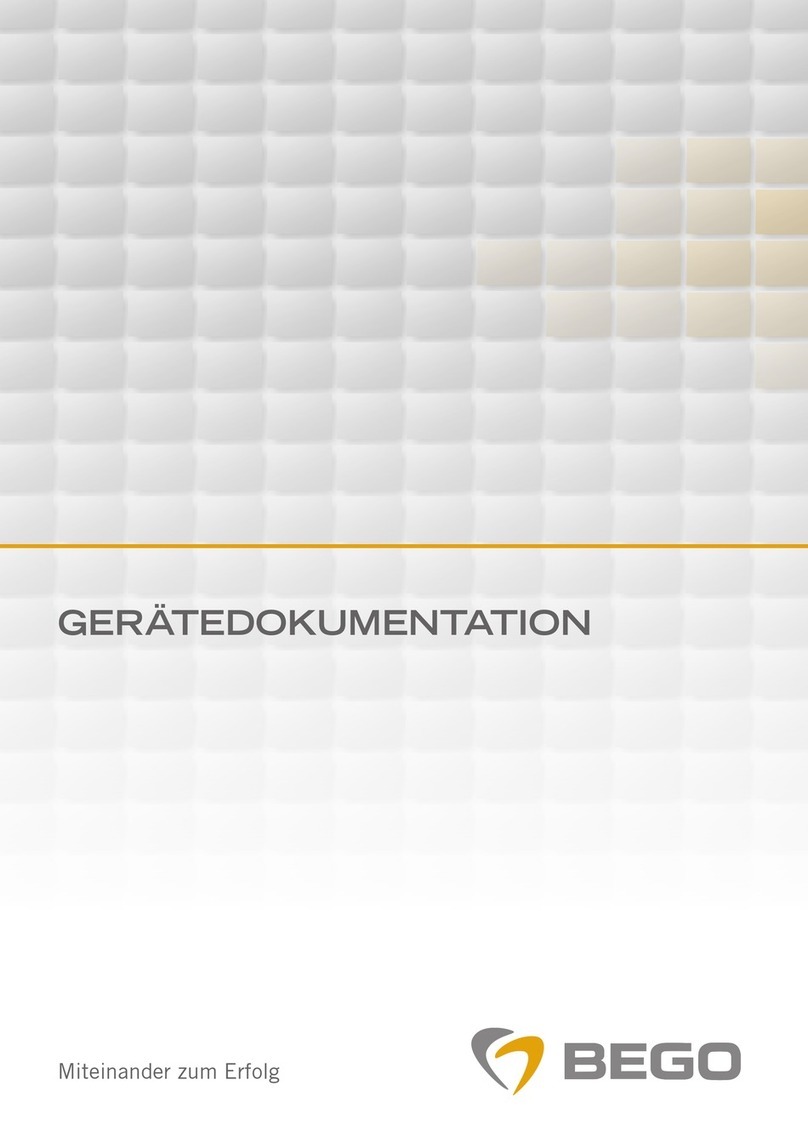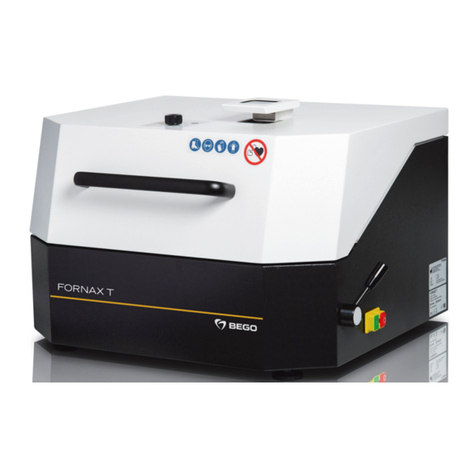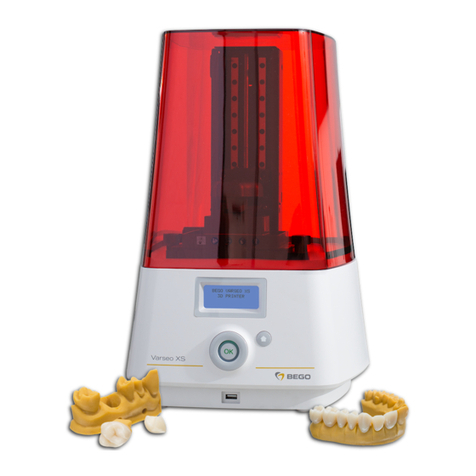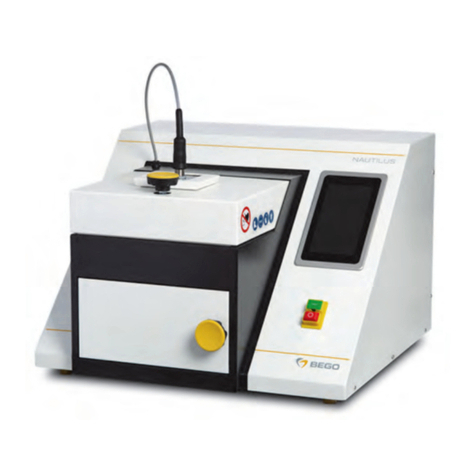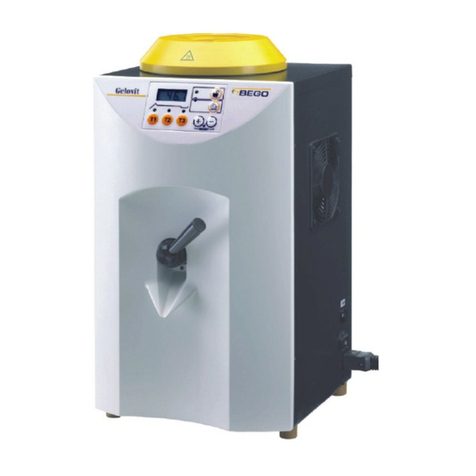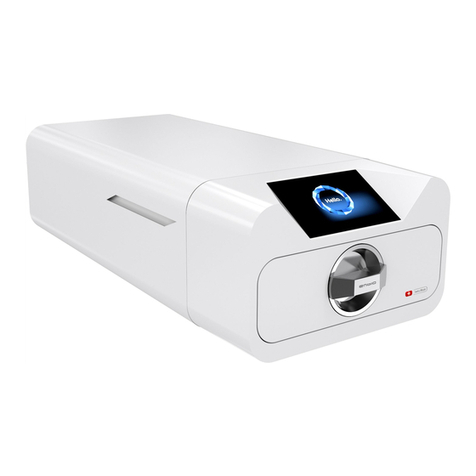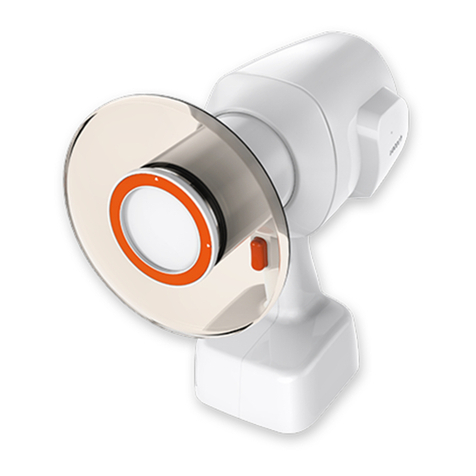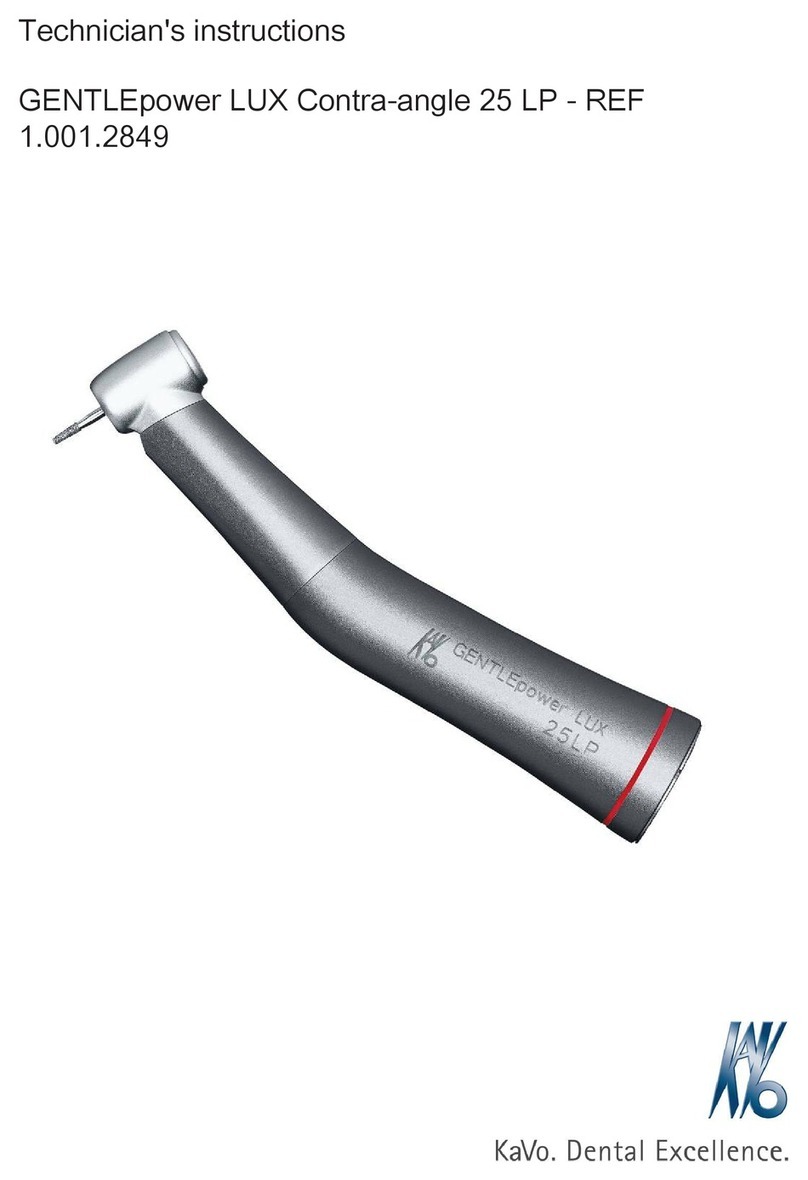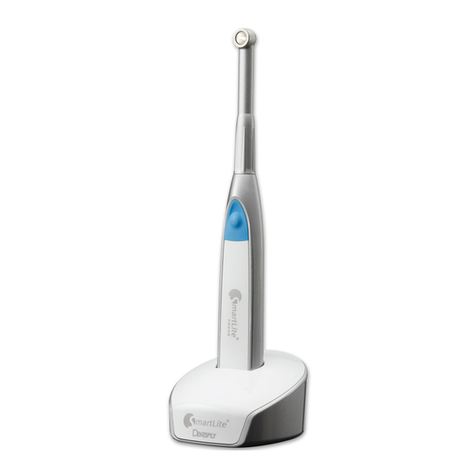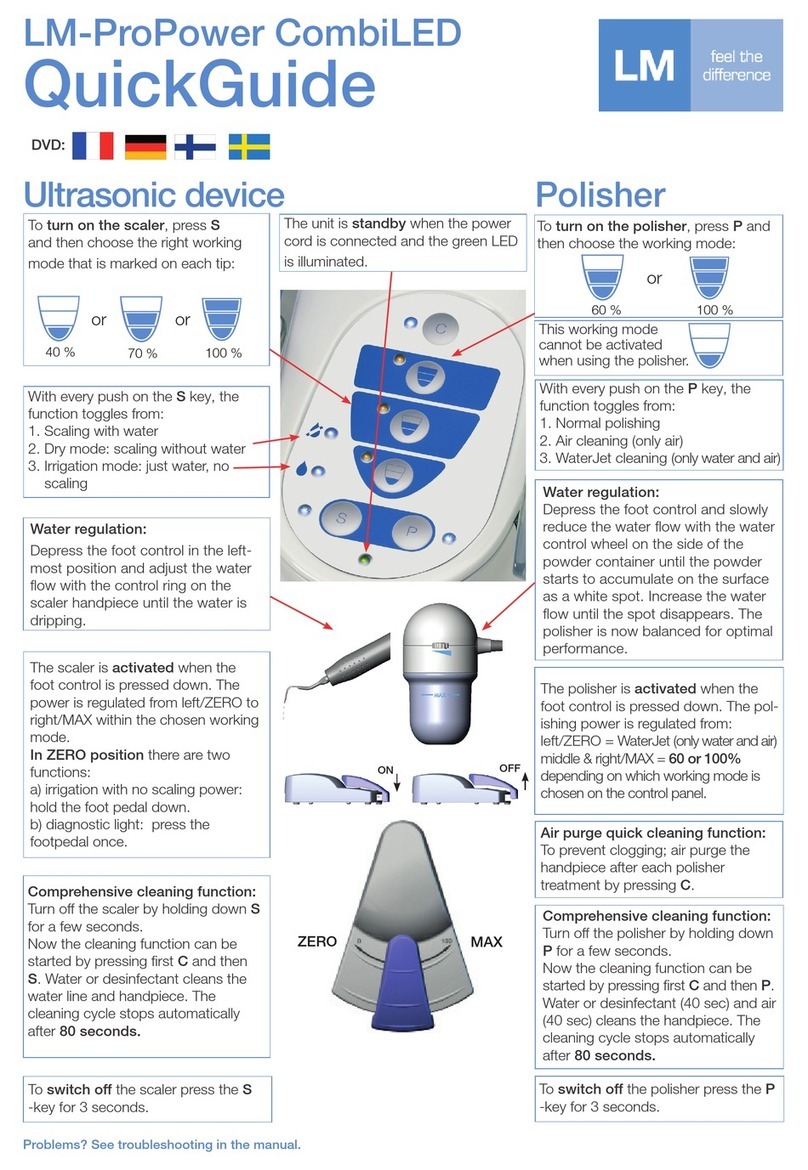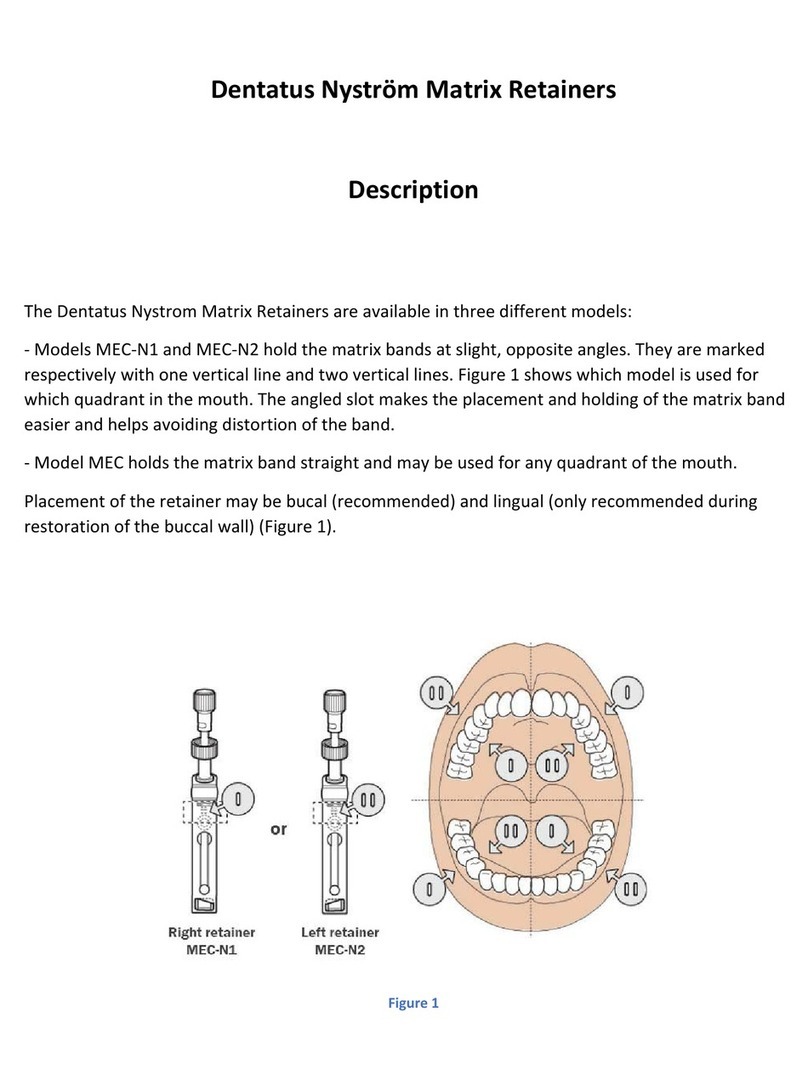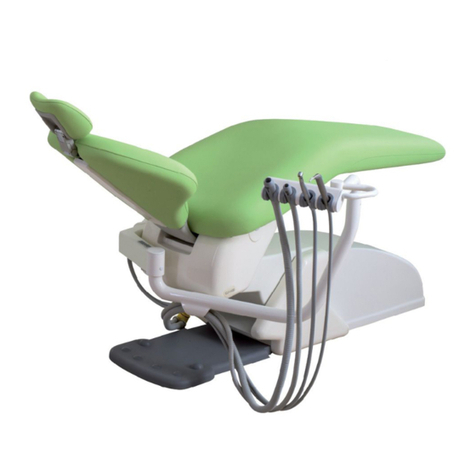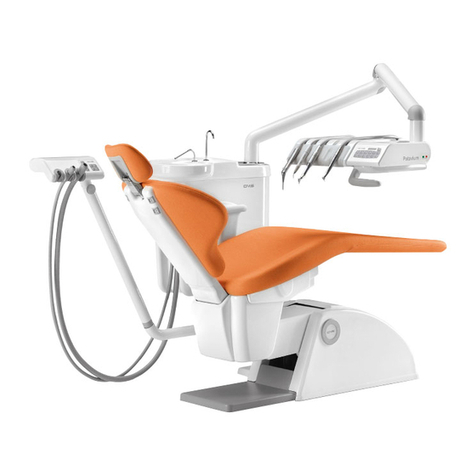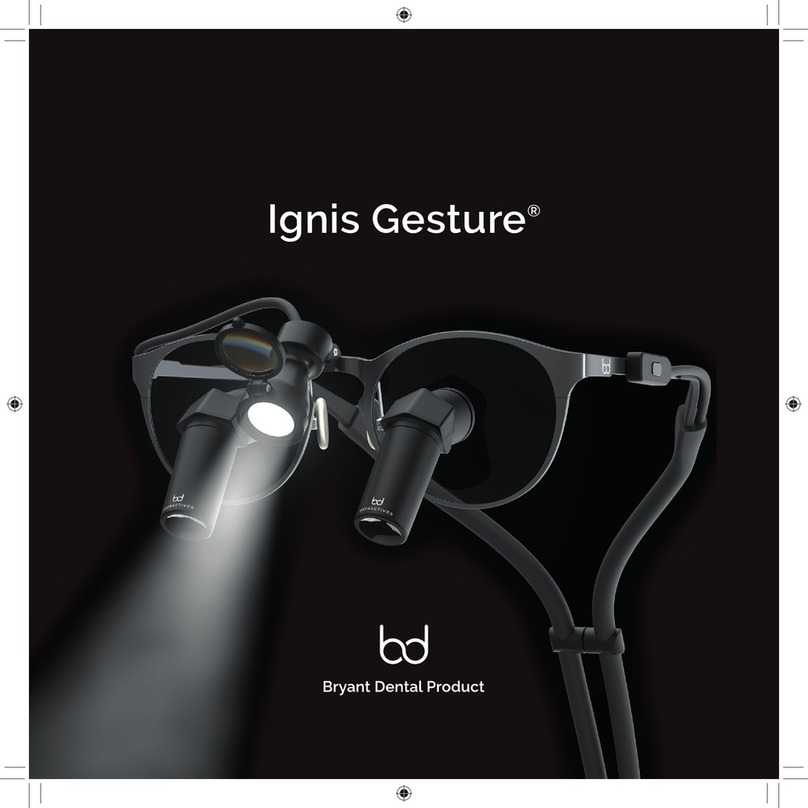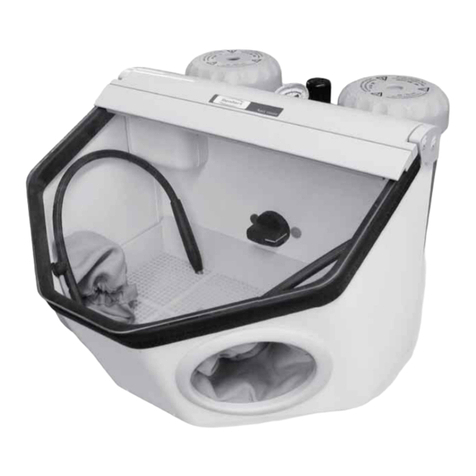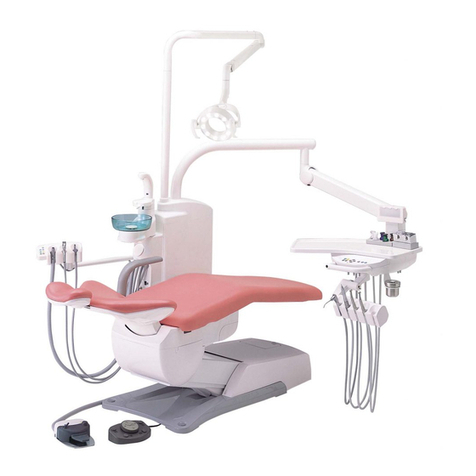Bego Otoflash User manual

OPERATING INSTRUCTIONS
Otoflash
en
English
Otoflash

16
86089 BA-en/00
English
⋅
Otoflash
en
Table of contents
General Information .............................................17
Warranty and Liability...........................................19
Safety instructions................................................20
Device description................................................21
Scope of delivery and extras................................22
Technical data ......................................................23
Installation............................................................23
Commissioning.....................................................24
Operation‒Use with timer....................................25
Protective gas option............................................26
Service and Maintenance.....................................27
Troubleshooting ...................................................28
Disposal ...............................................................28
Declaration of Conformity..........................Appendix
This device documentation is part of the device
and must be enclosed when selling or passing
on the device.
• The device has been designed solely for use in
dental laboratories and comparable institutions
for research, commercial and training purpos-
es. The device must only be operated by dental
professionals; trainees and other persons oper-
ating the device must be supervised.
• The operating instructions must be read and
understood before the device is used. This
applies, in particular, to Safety Instructions.
Damages caused by failure to observe these
operating instructions will invalidate any and all
warranty claims. We shall not accept any liabil-
ity for any resulting consequential damages.

English
⋅
Otoflash
17
86089 BA-en/00
en
General Information
Importance of the operating Instructions
These operating instructions cover all the infor-
mation that is necessary according to the relevant
regulations for the safe operation of the device
described herein.
The operating instructions are a part of the device.
The operating instructions should therefore
• always be kept at hand near the device until the
device is disposed of,
• and should be passed on with the device when
it is sold, transferred or rented/leased out.
Contact the manufacturer if you are unsure about
anything in the operating instructions.
We welcome any suggestions or contributions;
please feel free to contact us. Your effort will help us
make the operating instructions more user-friendly
and respond more effectively to your needs and
requirements.
Target group
This document is directed toward everyone who
works with this device or performs service tasks that
are described in this document.
Contact:
BEGO Bremer Goldschlägerei
Wilh. Herbst GmbH & Co. KG
Wilhelm-Herbst-Str. 1
28359 Bremen • Germany
Phone: +49 421 2028-0
Service-Hotline Phone: +49 421 2028-270
www.bego.com
Manufacturer:
NK-Optik GmbH
Isarstraße 2
82065 Baierbrunn • Germany
Tel. +49 89 74 4145-0
www.nk-optik.de
These operating instructions are protected by copyright. All rights reserved.
Any reproduction of these operating instructions, in whole or in part, is prohibited without the express
consent of NK Optik GmbH.

18
86089 BA-en/00
English
⋅
Otoflash
en
Conventions
These operating instructions contain references to
residual hazards, important user tips and handling
instructions that are identified with the following
symbols and words.
DANGER
This reference identifies hazards that
can cause serious bodily injury or
death if the relevant hazard instruc-
tions are not followed or not followed
properly.
WARNING
This reference identifies hazards that
can cause bodily injury or property
damage if the relevant hazard instruc-
tions are not followed or not followed
properly.
CAUTION
This reference identifies only those
hazards that are potential damaging
to property and the environment.
NOTE
This symbol identifies user tips and particularly
useful information. It helps you optimally exploit
all the functions of your machine.
1. Sequential actions are described in sequentially
numbered paragraphs.
→Cross-references are identified with this symbol.

English
⋅
Otoflash
19
86089 BA-en/00
en
Warranty and Liability
Our "General terms and conditions of sale and
delivery" apply. These are made available to the
customer upon completion of the contract, at the
latest. Warranty and liability claims for personal
injury and property damage are excluded if these
are attributable to one or more of the following
causes:
• Improper use of the device;
• Improper installation, commissioning, operating
and maintenance of the device;
• Operating the device with safety installa-
tions/safeguards that are defective, improperly
installed or inoperable;
• Failure to observe the notes contained in these
operating instructions regarding the transport,
storage, installation, commissioning, operation,
service and maintenance of this device;
• Unauthorized structural modifications to this
device;
• Inadequate monitoring/inspection of device
parts that are subject to wear;
• Improperly performed repairs;
• Disastrous situations/emergencies caused by
foreign objects or force majeure.
Intended use
This flashlight polymerisation device is intended
solely for curing light-curable resins.
Any other use is strictly prohibited.
Any use deviating from the specified use is deemed
improper use and is strictly prohibited.
Prohibited are:
• the use of the device if it is not in perfect condi-
tion or in case of safety-relevant device mal-
functions,
• any operation without protective covers or pro-
tective equipment/safeguards,
• working with the device without wearing protec-
tive clothing,
• unauthorized modifications to the device,
• the assignment of unqualified personnel.
The manufacturer has no knowledge of any
improper use up to this time.
Exclusion of liability in case of modifications
If a user or operating company modifies the flash-
light polymerization device and such modification
affects any aspect of the performance data or
intended functionality within the context of the appli-
cable standard, the person or organization making
the modification is responsible for the reclassifi-
cation and appropriate marking of the flash-light
polymerization device and will subsequently be
classified as the "manufacturer.

20
86089 BA-en/00
English
⋅
Otoflash
en
Safety instructions
Special safety instructions regarding this device
DANGER
Danger due to electric shock
Switch the device off and disconnect it
from the power supply before carrying
out any service or maintenance work!
WARNING
Risk of injury
Do not, under any circumstances,
look directly into the rays of the
flash-lights (risk of damage to
eyes)
WARNING
Risk of injury
The polymerization chamber may
heat up after longer radiation
periods.
It is thus recommended to wait a
few seconds before opening the lid
after the end of the polymerization
process (the fan continues to run).
CAUTION
Property damage
• The device will only work when the flash mod-
ule is completely inserted.
• Likewise, the lid must be closed all the way.
• Never operate the device without the flash
module.
CAUTION
Property damage
• The dust filter behind the display on the front of
the device should be kept clean.
• The dust filter should be cleaned or replaced
regularly depending on the degree of soiling
(see service and maintenance)

English
⋅
Otoflash
21
86089 BA-en/00
en
Device description
Otoflash
Otoflash is a flash-light polymerization device for the
curing of light-curable resins. In the operating mode,
two flash bulbs fitted at the bottom produce ten
flashes per second. The respective light radiation at
a wavelength of 300-700 nm is very intense.
Compared to other light sources, this achieves a
better curing of the materials, resulting in very good
physical characteristics and reduced residual
monomer content.
Fig. 1 Otoflash

22
86089 BA-en/00
English
⋅
Otoflash
en
Scope of delivery and extras
Scope of delivery
Otoflash REF
100, 115, 230 VAC, 50/60 Hz............................................................................................................... 26465
with:
• Polymerization tray with UVB blockers 360N2 (2x)
• Connection hose 2.5 m with quick coupling NW 7.2
• Translation of the original operating instructions
• Power cable (1x Europe, 1x USA/Japan)
Accessories
Cylinder pressure reducer for nitrogen................................................................................................. 20349
Wear Parts
Flash module ....................................................................................................................................... 20354
NOTE
All wear parts listed here will not be replaced free
of charge under the warranty or BEGO
guarantee.

English
⋅
Otoflash
23
86089 BA-en/00
en
Technical data
Nominal voltage. ...........................................................................................................100,115, 230 Volt AC
Nominal frequency ...........................................................................................................................50/60 Hz
Power consumption ................................................................................................................approx. 250 W
Dissipated power ....................................................................................................................approx. 200 W
Image frequency ......................................................................................................... 10 flashes per second
Lifetime of the flash tubes ................................................................................... average approx. 250 hours
Digital timer .............................................................................................. adjustable from 1 to 9999 flashes
Size of the polymerization chamber....................................................................approx. 120 x 120 x 50 mm
Spectral distribution.................................................................................................................. 300 - 700 nm,
.............................................................................................................. Maximum between 400 and 500 nm
Dimensions .......................................................................................................approx. 310 x 310 x 140 mm
Weight.........................................................................................................................................approx. 6 kg
Option protective gas ................................................................................minimum nitrogen N2, 2.6 N2, 2.6
.............................................................................................................................. Gas pressure: 1.0-1.2 bar
..............................................................................................................................Gas flow: approx. 10 l/min
Installation
Electricity
NOTE
Ensure ample space to the wall so that the lid can
be opened without being obstructed and that
there is sufficient space for ventilation.
DANGER
Danger due to electric shock
Check if the specifications on the type
plate correspond to the power supply
network before connecting the device.
Consult an electrician in case of
uncertainty.
The device is subject to protection
class I and must only be connected to
properly grounded power sources.

24
86089 BA-en/00
English
⋅
Otoflash
en
Commissioning
Before commissioning, set the device to the correct input voltage using the selector switch (12) on the back
of the device.
When moving the device from colder to warmer ambient temperatures (e.g. transport in the winter), allow it
to acclimatize for a minimum of 2 hours (to prevent the risk of flashovers inside the device).
Fig. 2 Front side
Fig. 3 Rear side
1. Power switch (mains switch)
2. Protective gas switch
3. Protective gas indicator lights
4. Display with keypad
5. Start button
6. Lamp indicator lights
7. Ready indicator
8. Polymerization chamber
9. Fan
10. Protective gas connection
11. Type plate
12. Selector switch (100, 115, 230 V)
13. Mains socket with fuse
14. Operating hour meter
Holding trays:
2 Plexi trays with UVB blockers are available,
labelled 360N2.
123 67
8
45
910121314
11

English
⋅
Otoflash
25
86089 BA-en/00
en
Operation‒Use with timer
Fig. 4 Front side
Setting the timer
The device is switched on with the power switch (1),
the green indicator labelled "Ready" (7) will light up
and a 4-digit figure will appear on the display (4).
This figure indicates the number of flashes. The
number of flashes can be programmed any number
between 0 and 9999 by pressing the buttons 1000,
100, 10 and 1.
Operating mode
The program is started by pressing the start button
(5). The timer will start to count down with every
flash. When the programmed number of flashes
have been completed, an acoustic signal will sound
three times and the word "End" will appear on the
display. Afterwards, the timer will be set to the
initially programmed number of flashes again. If the
lid is opened during the process, the entire device
will immediately be disconnected from the power
supply (except the timer), the word "open" appears
on the display and a long acoustic signal will sound.
Thus,the program can be interrupted at any time by
opening the lid. When the lid is subsequently closed
again, the program will return to the initially
programmed number of flashes.
Error message
The red field on the display labelled lamp (6) will
light up if one or both of the flash bulbs are
defective.
123 67
8
45

26
86089 BA-en/00
English
⋅
Otoflash
en
Protective gas option
In addition to the operating controls and installations
listed up to this point, the protection gas option also
has the following component:
A quick coupler connection (nominal width 7.2) for a
nitrogen cylinder located on the back of the device.
Set the pressure regulating valve to 1.0 to 1.2 bar
and connect the device to the nitrogen cylinder
using a quick coupler (not included in the scope of
delivery).
A control panel for protective gas is located between
the power switch and the display on the front of the
device. The protective gas is added with the switch.
The switch has 3 switching states:
• Position I (switch turned to the top) and green
LED on
• Position 0 (center position): no LED on
• Position II (switch turned to the bottom): no LED
on
Switch position I:
The protective gas function, including the pre-flood
function (rinsing the polymerization chamber with
nitrogen for 30 seconds before light exposure) is
activated.
After 30 seconds, the flash-light will start; simultane-
ously, the polymerization chamber will be flooded for
another 60 seconds.
The yellow LED (labelled "ok") will be on during the
inflow of protective gas; if the pressure is insufficient
(< 0.8 bar) or if there is no gas flow, the yellow LED
will go off and the red LED (labelled "def.") will light
up. After a total of 90 sec. (60 sec after the light
exposure has started), the flooding with N2 will be
stopped automatically. The yellow LED will go off.
Once the programmed light exposure time has
elapsed, the flooding with N2 will be stopped as
well, even if the light exposure time was < 60 sec.
Switch position 0:
The protective gas option is turned off,
Switch position II:
The protective gas function is activated, however
without pre-flooding. The protective gas flows into
the chamber with the start of the light exposure. The
polymerization chamber will be flooded with the
protective gas during the entire polymerization time.
The yellow LED (labelled "ok") will be on during the
inflow of protective gas; if the pressure is insufficient
(< 0.8 bar) or if there is no gas flow, the yellow LED
will go off and the red LED (labelled "def.") will light
up (like with switch position i). Once the
programmed light exposure time has elapsed, the
flooding with N2 will be stopped as well.
The gas flow amounts to approx. 10-11 litres per
minute (with 1.0 to 1.2 bar at the reducing valve) and
the atmospheric oxygen in the tray will be displaced.
This will prevent oxygen inhibitation and the surface
of the workpieces will cure without oxygen inhibi-
tation.
Notes:
Complete curing with protective gas only works
when the Plexi trays are used.
Use nitrogen N2, technical standard with purity level
2.6 (purity level 99.6%) or higher.
The switch positions cannot be changed during the
program sequence.
WARNING
Risk of injury
Use a pressure reduction valve,
max. allowed pressure 8 bar.

English
⋅
Otoflash
27
86089 BA-en/00
en
Service and Maintenance
Cleaning
All external surfaces can be wiped with mild
household cleaner or alcohol.
The flash module must only be blown out with
compressed air with slight overpressure.
Never clean the flash bulbs with cleaning agents or
cloths. Only the reflector may be cleaned with a lint-
free cloth.
Dust filter
The filter fleece (1) located directly behind the
display (accessible when the lid is open) should be
blown out with compressed air and cleaned or
replaced regularly, depending on the degree of dust.
Service/Customer service
Service must only be carried out by the manufac-
turer, BEGO or persons, who have been authorized
by the manufacturer or BEGO.
Replacing the flash module
Fig. 5 Otoflash opened
1Dust filter
2Flash module
The flash bulbs can only be replaced as a complete
flash module. Allow old flash bulbs to cool off, as
needed; to that end, let the device run in standby
mode for approx. 1 minute.
1. Switch the device off disconnect it from the
power supply.
2. Open the lid.
3. Remove the 4 screws inside of the device and
pull the flash module (2) up and out. Install the
new flash module in reverse direction.
4. Important: Never touch the flash bulbs with the
fingers as fingerprints and marks may burn into
the glass otherwise. Should the flash bulbs be
touched accidently, it is imperative to clean
them with isopropyl or ethyl alcohol.
5. Disposal of the tubes: Used flash tubes are
hazardous waste and must be disposed of in
accordance with statutory regulations.
DANGER
Danger due to electric shock
Switch the device off and disconnect it
from the power supply before carrying
out any service or maintenance work!
CAUTION
Property damage
No liquids must enter the housing of
the device or the power switches.
1
2

28
86089 BA-en/00
English
⋅
Otoflash
en
Troubleshooting
Please contact the local retailer if the device is not
working properly or if you have any other questions,
Have servicing work carried out only by authorized
BEGO workshops!
Technical service hotline:
+49 (421) 2028 - (270 … 274)
Disposal
Instructions for disposal of the device
(Applicable only within the European Union)
The adjacent symbol on the type plate of the device indicates the device, in
accordance with the European directive on waste electrical and electronic equipment,
may not be disposed of as normal domestic waste.
As a customer, you contribute to the protection of the environment when you dispose
of the device correctly.
Disposal in Germany
The disposal lies within the responsibility of the user/operating company; the the
relevant national legal requirements must be observed.
The device may be returned to the manufacturer for disposal (at no cost for the
manufacturer).
Please contact the manufacturer when it is time to dispose of the device.
Disposal in other countries of the European Union
Please contact the company from which you purchased the device when it is time to
dispose of it.
Resin waste treatment
Solidified resin can be disposed of with household waste. Do not contaminate
standing or flowing waters with resin. Dispose of empty resin containers and contam-
inated materials in accordance with local regulations. Dispose according to EC Direc-
tives on waste and hazardous waste.
Other manuals for Otoflash
1
Table of contents
Other Bego Dental Equipment manuals
Popular Dental Equipment manuals by other brands
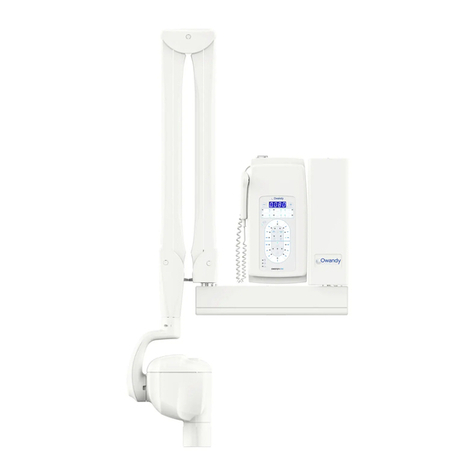
Owandy Radiology
Owandy Radiology RX-AC user manual
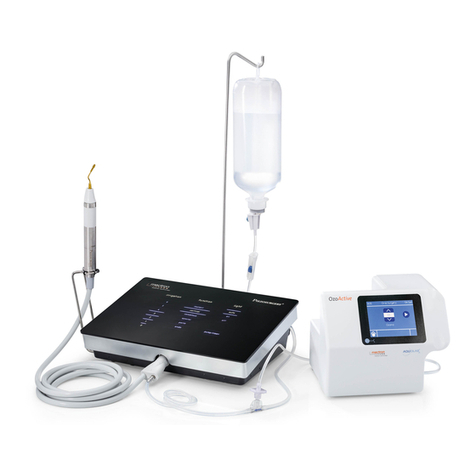
mectron
mectron Piezosurgery Cleaning and sterilization manual

Belmont
Belmont CREDIA G1 operating instructions

Planmeca
Planmeca Sovereign Classic user manual
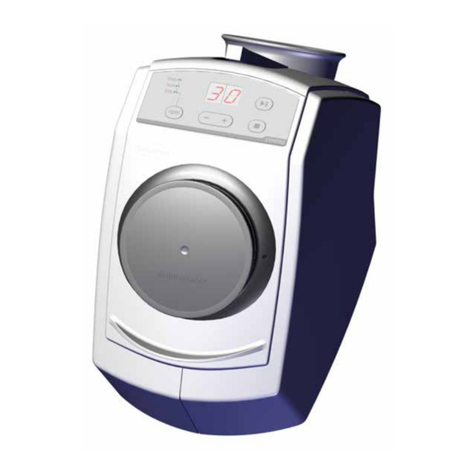
Renfert
Renfert SYMPRO Operating and safety instructions
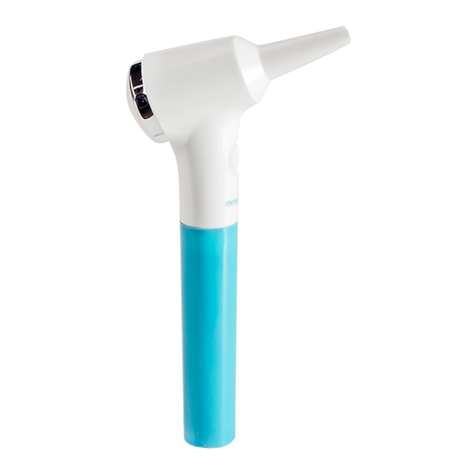
Nevadent
Nevadent NZPS 3 A1 operating instructions
